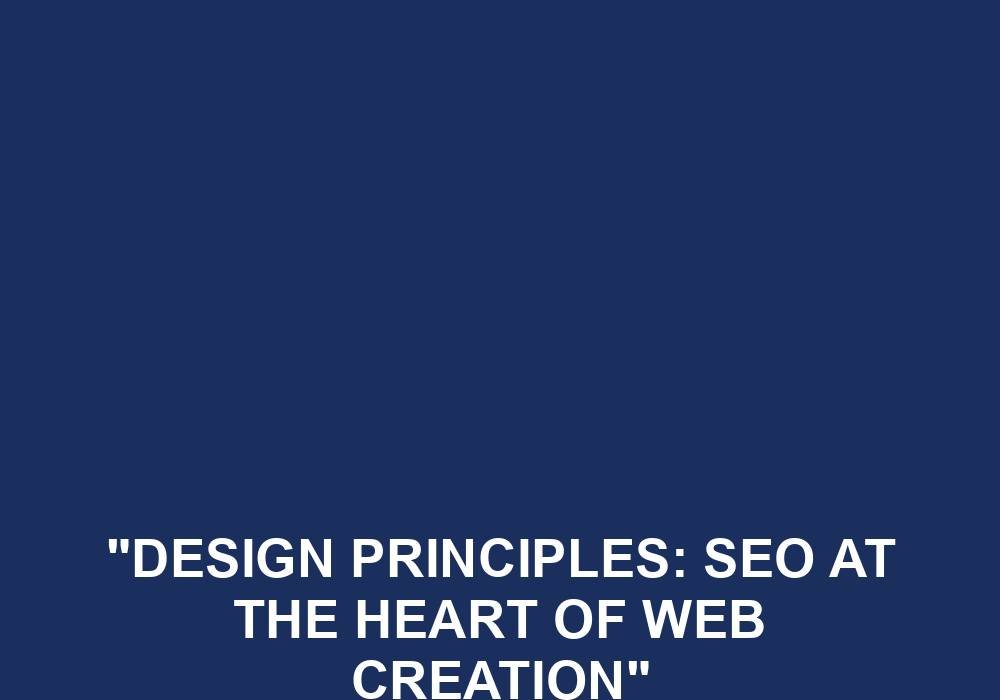Welcome to the world of web design! In this exciting journey, we’ll explore how to create stunning websites that not only look great but also rank high on search engines. Yes, we’re talking about “Design Principles: SEO at the Heart of Web Creation.”
Imagine having a website that not only captivates visitors with its beautiful layout but also attracts organic traffic from search engines like Google. Sounds intriguing, doesn’t it? Well, that’s exactly what we’ll be delving into—the art of combining visually appealing designs with strategic SEO techniques.
So, if you’re ready to discover the secrets behind creating websites that are both aesthetically pleasing and search engine friendly, buckle up and let’s dive deep into the world of design principles and SEO!
Design Principles: SEO at the Heart of Web Creation
Welcome to our comprehensive guide on design principles that place SEO at the core of web creation. In this article, we will explore the critical role SEO plays in web design and how incorporating SEO strategies from the outset can lead to a more successful and effective website. From user experience to site structure and content optimization, we’ll delve into the key factors that can drive organic traffic and boost your website’s visibility in search engine rankings.
The Importance of Keywords in Web Design
Keywords are the building blocks of SEO, and their strategic placement within a website’s design can significantly impact its visibility in search engine results. By conducting thorough keyword research, we can identify the terms and phrases users are actively searching for and integrate them seamlessly into our website’s architecture. By optimizing page titles, headers, meta descriptions, and alt tags with relevant keywords, we can signal to search engines what our website is about and improve its chances of ranking higher in search results.
Furthermore, when it comes to content creation, keywords are crucial for aligning the website’s messaging with the target audience’s search intent. By strategically incorporating keywords into our website’s copy, we can deliver valuable and relevant content that directly addresses the user’s needs, increasing the chances of engagement, conversion, and ultimately, higher search rankings.
However, it’s important to strike the right balance. Keyword stuffing, or overloading a website with keywords in an unnatural manner, can result in penalties from search engines. Instead, focus on creating content that provides value and integrates keywords seamlessly and naturally.
User Experience: The Backbone of SEO
When it comes to web design, user experience (UX) is more than just aesthetics. It plays a vital role in enhancing a website’s SEO performance. Search engines prioritize websites that provide exceptional user experiences, such as fast loading speeds, intuitive navigation, and mobile-friendliness.
Optimizing the website’s loading speed is crucial, as slow-loading pages can frustrate users and lead to higher bounce rates. Compressing images, leveraging browser caching, and reducing unnecessary code are just a few techniques that can improve a website’s performance.
Additionally, intuitive navigation structures and user-friendly interfaces can make it easier for visitors to find the information they need. Clear menu structures, organized content layouts, and logical site hierarchies contribute to a positive user experience, encouraging users to spend more time on the site and explore further.
Social Media Integration: Amplifying Your Reach
In the age of social media dominance, ensuring that your website and its content are easily shareable across various platforms is essential for boosting visibility and driving traffic. By incorporating social media integration into your web design, you can leverage the power of social sharing, allowing visitors to easily share your content with their networks.
Furthermore, social media integration can lead to increased engagement and brand awareness. By including social media buttons on your website, you invite visitors to connect with your brand on other channels, building a stronger online presence.
Remember to create compelling, share-worthy content. By producing high-quality, informative, and entertaining content, you encourage visitors to engage with and share your website’s content, potentially increasing your exposure and driving traffic from various social media platforms.
The Benefits of Responsive Design in SEO
In today’s mobile-first world, responsive design is crucial for a successful website. With the majority of internet users accessing the web through mobile devices, search engines prioritize mobile-friendly websites in their rankings. By implementing responsive design principles, websites can adapt seamlessly to various screen sizes and devices, providing optimal user experiences regardless of the device used.
Responsive design also offers several SEO benefits. Firstly, it consolidates website authority. With a single URL across all devices, all inbound links and social shares lead to the same page, boosting the website’s overall authority and visibility in search results.
Moreover, responsive design simplifies website management. Instead of maintaining two separate websites (one for desktop and one for mobile), a responsive design eliminates the need for duplicate content and reduces the risk of duplicate content penalties from search engines.
Optimizing Site Structure for Search Engines and Users
The structure of your website plays a pivotal role in its SEO performance. Search engines prioritize websites with clear and organized structures, as they allow for better crawling and indexing of content.
Create a logical hierarchy of pages and categories, utilizing descriptive and keyword-rich URLs to define the website’s structure. This not only helps search engines understand the relationship between pages but also helps users navigate your site more easily.
Include an XML sitemap to enhance crawling and indexing efficiency. A sitemap provides a comprehensive list of pages on your website, aiding search engines in discovering and understanding your site’s structure.
Tips for Effective SEO Web Design
Incorporating SEO principles into your web design is a multifaceted process. To maximize your website’s potential, here are some key tips:
- Perform thorough keyword research to identify relevant keywords for your website.
- Optimize your website’s on-page elements, including page titles, headers, meta descriptions, and alt tags.
- Create valuable and engaging content that incorporates keywords naturally.
- Ensure your website is mobile-friendly and utilizes responsive design principles.
- Invest in a fast-loading website to enhance user experience.
- Integrate social media buttons to encourage social sharing and increase brand visibility.
- Create a clear and organized site structure to aid search engine crawling and enhance user navigation.
The Bottom Line: SEO and Web Design Go Hand in Hand
When it comes to web creation, incorporating SEO principles from the outset is crucial for maximizing your website’s visibility, organic traffic, and overall success. By focusing on user experience, keyword optimization, responsive design, and effective site structure, you can create a compelling website that not only engages visitors but also ranks well in search engine results. Remember, SEO should be ingrained in the design process from the beginning, leading to a seamless fusion of aesthetics and functionality that attracts and satisfies both users and search engines.
Key Takeaways: Design Principles – SEO at the Heart of Web Creation
- Designing websites with SEO in mind helps improve search engine rankings.
- Keyword research is crucial for optimizing web content.
- Creating user-friendly navigation enhances user experience and SEO.
- Optimizing website speed improves both user experience and SEO performance.
- Regularly updating and publishing fresh, high-quality content boosts SEO efforts.
Frequently Asked Questions
When it comes to web creation, design principles play a crucial role in creating a successful and user-friendly website. One important aspect of web design is incorporating SEO (Search Engine Optimization) techniques to ensure high visibility in search engine rankings. Here are some commonly asked questions about designing websites with SEO at the heart of the process.
1. Why is SEO important in web creation?
SEO is essential in web creation because it helps improve a website’s visibility in search engine results. When a website is optimized for search engines, it increases the chances of appearing on the first page of search results, attracting more organic traffic. By following SEO best practices, you can enhance user experience, improve website performance, and increase the website’s ranking, ultimately driving more visitors to your site.
Without incorporating SEO, your website may go unnoticed by search engines, resulting in limited visibility to potential users. By prioritizing SEO and implementing effective strategies, you can make your website more discoverable, leading to increased online presence and better chances of reaching your target audience.
2. What are the key design principles for SEO-friendly websites?
There are several design principles that contribute to creating an SEO-friendly website:
– Responsive design: Ensuring your website is easily accessible and user-friendly across various devices and screen sizes.
– Fast loading speed: Optimizing your website’s performance to provide a seamless browsing experience for users and search engine crawlers.
– Relevant and quality content: Creating and regularly updating high-quality content that is relevant to your target audience and industry.
– Proper use of keywords: Incorporating relevant keywords naturally throughout your website’s content, including meta tags and URLs.
– User-friendly navigation: Organizing your website’s structure and navigation in a way that is intuitive and easy for both users and search engines to navigate.
By adhering to these design principles, you can create a website that is not only visually appealing but also optimized for search engines, leading to higher rankings and increased organic traffic.
3. How can I optimize my website’s on-page SEO?
To optimize your website’s on-page SEO, consider the following strategies:
– Optimize your page titles and meta descriptions, incorporating relevant keywords and accurately reflecting the content of each page.
– Utilize header tags (e.g., H1, H2) to structure your content and make it easier for search engines to understand.
– Optimize your images by using descriptive alt tags and compressing their file sizes to improve page loading speed.
– Create unique and compelling content for each page, avoiding duplicate content issues.
– Incorporate internal and external links within your content to provide additional context and enhance navigation.
– Use schema markup to provide additional information to search engines about your content.
By implementing these on-page SEO strategies, you can improve your website’s visibility in search engine results and attract more organic traffic.
4. How can I ensure my website is mobile-friendly?
To ensure your website is mobile-friendly, here are some key steps:
– Use a responsive design that adapts to different screen sizes, ensuring your website looks and functions well on mobile devices.
– Optimize your images and graphics for mobile devices to improve loading speed.
– Avoid using Flash, as it is not supported on most mobile devices.
– Make sure your font sizes are legible on smaller screens.
– Test your website’s mobile-friendliness using Google’s Mobile-Friendly Test tool.
– Incorporate mobile-friendly navigation, such as a hamburger menu, to enhance user experience on mobile devices.
By implementing these practices, you can create a website that is both visually appealing and user-friendly across different devices, providing a positive experience for mobile users.
5. How can I analyze and track the performance of my website’s SEO?
There are several tools and techniques to analyze and track the performance of your website’s SEO:
– Use Google Analytics to gain insights into your website’s traffic, user behavior, and conversions.
– Utilize Google Search Console to monitor your website’s performance in search results, discover crawl errors, and submit sitemaps.
– Conduct regular keyword research to identify opportunities and monitor your website’s rankings using tools like SEMrush or Moz.
– Monitor user engagement metrics, such as bounce rate and time on page, to evaluate the effectiveness of your website’s content.
– Set up goal tracking in Google Analytics to measure the success of specific actions, such as form submissions or purchases.
By using these tools and techniques, you can gain valuable insights into your website’s SEO performance, identify areas for improvement, and make data-driven decisions to enhance your website’s visibility and user experience.
Summary
Want your website to be found on the internet? You need to think about SEO. SEO stands for Search Engine Optimization. It’s all about making your website more visible to search engines like Google. By following some design principles and using keywords effectively, you can improve your website’s ranking and attract more visitors. Don’t forget about user experience – make sure your site is easy to navigate and loads quickly. With SEO at the heart of web creation, you can create a website that stands out and gets noticed.





